The Coordination Behavior of Two New Complexes, [(C7H10NO2)CdCl3]n(I) and [(C7H9NO2)CuCl2] (II), Based on 2,6-Dimethanolpyridine; Elaboration of the Structure and Hirshfeld Surface, Optical, Spectroscopic and Thermal Analysis
Abstract
:1. Introduction
2. Materials and Methods
2.1. Synthesis of Metal Complexes
2.2. Investigation Techniques
2.3. Spectroscopic Measurements
2.4. Thermal Study
2.5. Computational Methods
3. Results and Discussion
3.1. Powder X-ray Diffraction Patterns and SEM/EDX Analysis
3.2. Crystal Structure
3.2.1. Crystal Structure of [(C7H10NO2)CdCl3]n(I)
3.2.2. Crystal Structure of [(C7H9NO2)CuCl2] (II)
3.3. Hirshfeld Surface Analysis
3.4. Vibrational Study
3.5. Optical Study
3.6. Thermal Analysis
4. Conclusions
Supplementary Materials
Author Contributions
Funding
Institutional Review Board Statement
Informed Consent Statement
Data Availability Statement
Acknowledgments
Conflicts of Interest
References
- Long, G.S.; Wei, M.; Willett, R.D. Crystal structures and magnetic properties of a novel layer perovskite system:(3-Picoliniumylammonium) CuX4 (X = Cl, Br). Inorg. Chem. 1997, 36, 3102–3107. [Google Scholar] [CrossRef]
- Baccar, I.; Issaoui, F.; Zouari, F.; Hussein, M.; Dhahri, E.; Valente, M.A. Magneto-structural studies of the bis (1, 4-bis (3-aminopropylamine) piperazinium) chloride pentachlorocuprate (II) trihydrate. Solid State Commun. 2005, 150, 2005–2010. [Google Scholar] [CrossRef]
- Parent, A.R.; Landee, C.P.; Turnbull, M.M. Transition metal halide salts of N-methylmorpholine: Synthesis, crystal structures and magnetic properties of N-methylmorpholinium salts of copper (II), cobalt (II) and manganese (II). Inorg. Chim. Acta 2007, 360, 1943–1953. [Google Scholar] [CrossRef]
- Issaoui, F.; Baccar, I.; Dhahri, E.; El-Sadek, O.; Zouari, F.; Hlil, E.K. Synthesis, Crystal Structure, Magnetism, Band Structure and Density of States of [C6H18N3]Cl CoCl4. J. Supercond. Nov. Magn. 2012, 25, 1563–1570. [Google Scholar] [CrossRef]
- Luque, A.; Sertucha, J.; Castillo, O.; Roman, P. Magneto-structural studies and thermal analysis of n-ethylpyridinium (n = 2, 3, 4) tetrabromocuprate (II) complexes. Polyhedron 2002, 21, 19–26. [Google Scholar] [CrossRef]
- Mitzi, D.B. Templating and structural engineering in organic–inorganic perovskites. J. Chem. Soc. Dalton Trans. 2001, 1, 1–12. [Google Scholar] [CrossRef]
- Hermi, S.; Alotaibi, A.A.; Lefebvre, F.; Nasr, C.B.; Mrad, M.H. Elaboration, crystal structure, physico-chemical characterization and theoretical investigation of a new non-centrosymmetric Sn (IV) complex (C4H12N2)[SnCl6] · 3H2O. J. Mol. Struct. 2020, 1216, 128296. [Google Scholar] [CrossRef]
- Ayari, C.; Althobaiti, M.G.; Alotaibi, A.A.; Almarri, A.; Ferretti, V.; Ben Nasr, C.; Mrad, M.H. Synthesis, Crystal Structure, Hirshfeld Surface, and Physicochemical Characterization of New Salt Bis (2-ethyl-6-methylanilinium) tetrachloromercurate (II)[C9H14N] 2HgCl4. J. Chem. 2021, 2021, 2857369. [Google Scholar] [CrossRef]
- Alotaibi, A.A.; Shukla, A.K.; Mrad, M.H.; Alswieleh, A.M.; Alotaibi, K.M. Fabrication of Polysulfone-Surface Functionalized Mesoporous Silica Nanocomposite Membranes for Removal of Heavy Metal Ions from Wastewater. Membranes 2021, 11, 935. [Google Scholar] [CrossRef] [PubMed]
- Bel Haj Salah, S.; Hermi, S.; Alotaibi, A.A.; Alotaibi, K.M.; Lefebvre, F.; Kaminsky, W.; Ben Nasr, C.; Mrad, M.H. Stabilization of hexachloride net with mixed Sn (IV) metal complex and 2, 3-dimethylanilinium organic cation: Elaboration, optical, spectroscopic, computational studies and thermal analysis. Chem. Pap. 2022, 76, 1861–1873. [Google Scholar] [CrossRef]
- Alotaibi, A.A.; Ayari, C.; Bajuavfir, E.; Ahmad, A.; Al-Nahdi, F.; Alswieleh, A.M.; Alotaibi, K.M.; Mi, J.X.; Nasr, C.B.; Mrad, M.H. Stabilization of Tetrachloride with Mn (II) and Co (II) Complexes and 4-Tert-Butylpyridinium Organic Cation: Elaboration of the Structure and Hirshfeld Surface, Optical, Spectroscopic and Thermal Analyses. Crystals 2022, 12, 140. [Google Scholar] [CrossRef]
- Sharma, R.P.; Singh, A.; Venugopalan, P.; Yanan, G.; Yu, J.; Angeli, C.; Ferretti, V. “Caging” Anions through Crystal Engineering to Avoid Polymerization: Structural, Conformational and Theoretical Investigations of New Halocadmate [Cd2X7]3− Anions (X = Cl/Br). Eur. J. Inorg. Chem. 2012, 8, 1195–1203. [Google Scholar] [CrossRef]
- Luo, J.; Hong, M.; Wang, R.; Cao, R.; Shi, Q.; Weng, J. Self-Assembly of Five Cadmium (II) Coordination Polymers from 4.4’-Diaminodiphenylmethane. Eur. J. Inorg. Chem. 2003, 2003, 1778–1784. [Google Scholar] [CrossRef]
- Corradi, A.B.; Ferrari, A.M.; Pellacani, G.C. Organic-inorganic composite materials: Structural archetypes of linear polymeric chlorocadmates (II). Inorg. Chim. Acta 1998, 272, 252–260. [Google Scholar] [CrossRef]
- Mercier, N.; Louvain, N.; Wenhua, B. Structural diversity and retro-crystal engineering analysis of iodometalate hybrids. CrystEngComm 2009, 11, 720–734. [Google Scholar] [CrossRef] [Green Version]
- Mitzi, D.B. Synthesis, Structure, and Properties of Organic-Inorganic Perovskites and Related Materials. Prog. Inorg. Chem. 2007, 48, 1–121. [Google Scholar]
- Hermi, S.; Althobaiti, M.G.; Alotaibi, A.A.; Almarri, A.H.; Fujita, W.; Lefebvre, F.; Ben Nasr, C.; Mrad, M.H. Synthesis, Crystal Structure, DFT Theoretical CalculationandPhysico-Chemical Characterization of a New Complex Material (C6H8Cl2N2) 2 [Cd3Cl10]· 6H2O. Crystals 2021, 11, 553. [Google Scholar] [CrossRef]
- Gharbi, C.; Alotaibi, A.A.; Lucas, C.; Lefebvre, F.; Ben Nasr, C.; Mrad, M.H. Elaboration, Crystal Structure, Physicochemical Characterization and DFT Theoretical Calculation of a New Cd (II) Complex [C9H14N] 2CdCl4. J. Clust. Sci. 2021, 154, 1–9. [Google Scholar] [CrossRef]
- Passarelli, J.V.; Fairfield, D.J.; Sather, N.A.; Hendricks, M.P.; Sai, H.; Stern, C.L.; Stupp, S.I. Enhanced out-of-plane conductivity and photovoltaic performance in n= 1 layered perovskites through organic cation design. J. Am. Chem. Soc. 2018, 140, 7313–7323. [Google Scholar] [CrossRef]
- Wang, Y.J.; Li, H.H.; Chen, Z.R.; Huang, C.C.; Huang, X.H.; Feng, M.; Lin, Y. A series of lead (II)/iodine hybrid polymers based on 1-D and 2-D metal–organic motifs linked by different organic conjugated ligands. CrystEngComm 2008, 10, 770–777. [Google Scholar] [CrossRef]
- Even, J.; Pedesseau, L.; Katan, C.; Kepenekian, M.; Lauret, J.S.; Sapori, D.; Deleporte, E. Solid-state physics perspective on hybrid perovskite semiconductors. J. Phys. Chem. C 2015, 119, 10161–10177. [Google Scholar] [CrossRef] [Green Version]
- Pons, J.; Antón, J.G.; Bardia, M.F.; Calvet, T.; Ros, J. Coordination compounds of Cd (II) with several bidentate-NN′ and tridentate-NN′ N nitrogen donor ligands. 113Cd NMR studies of monomeric compounds containing nitrogen donor atoms. Inorg. Chim. Acta 2009, 362, 2698–2703. [Google Scholar] [CrossRef]
- Olekseyuk, I.D.; Gulay, L.D.; Dydchak, I.V.; Piskach, L.V.; Parasyuk, O.V.; Marchuk, O.V. Single crystal preparation and crystal structure of the Cu2Zn/Cd, Hg/SnSe4 compounds. J. Alloys Compd. 2002, 340, 141–145. [Google Scholar] [CrossRef]
- Neve, F.; Francescangeli, O.; Crispini, A. Crystal architecture and mesophase structure of long-chain N-alkylpyridiniumtetrachlorometallates. Inorg. Chim. Acta 2002, 338, 51–58. [Google Scholar] [CrossRef]
- Hannachi, N.; Bulou, A.; Chassenieux, C.; Guidara, K.; Hlel, F. Temperature study of [N (C3H7)4]2Cd2Cl6 by thermal analysis, Raman scattering, and X-ray powder diffraction: Evidence of phase transitions. Physica A 2011, 390, 2987–2994. [Google Scholar] [CrossRef]
- Peng, C.H. Bis (1-methylpiperazine-1,4-diium) tetrachloridocuprate (II). Acta Cryst. E 2011, 67, m979. [Google Scholar] [CrossRef]
- Bouacida, S.; Bouchene, R.; Khadri, A.; Belhouas, R.; Merazig, H. Bis [4-(dimethylamino) pyridinium] tetrachloridocuprate (II). Acta Cryst. E 2013, 69, m610–m611. [Google Scholar] [CrossRef] [Green Version]
- Kessentini, A.; Belhouchet, M.; Sunol, J.J.; Abid, Y.; Mhiri, T. Crystal structure, vibrational studies and optical properties of a new organic–inorganic hybrid compound (C10H28N4) CuCl5Cl⋅ 4H2O. Spectrochim. Acta A 2015, 134, 28–33. [Google Scholar] [CrossRef]
- Arularasan, P.; Sivakumar, B.; Chakkaravarthi, G.; Mohana, R. Bis (μ-l-arginine-κ3N2, O: O′)bis(l-arginine-κ2N2, O)tetra-μ-chlorido-tetrachloridotetracopper (II). Acta Cryst. E 2013, 69, m583–m584. [Google Scholar] [CrossRef]
- Dammak, T.; Boughzala, H.; Mlayah, A.; Abid, Y. Elaboration, structural, vibrational and optical investigation of a two-dimensional self-assembled organic–inorganic hybrid compound. J. Lumin. 2016, 173, 213–217. [Google Scholar] [CrossRef]
- Yilmaz, V.T.; Guney, S.; Thöne, C. Different Coordination Modes of Saccharin in the Complexes of Lead (II) with 2-Pyridylmethanol and Pyridine-2,6-dimethanol-Synthesis, Spectral and Structural Characterization. Z. Anorg. Allg. Chem. 2002, 628, 1406–1410. [Google Scholar] [CrossRef]
- Koman, M.; Melnik, M. Crystal and molecular structure of bis (2,6-dimethanolpyridine) copper (II) niflumate. Polyhedron 1997, 16, 2721–2726. [Google Scholar] [CrossRef]
- Farfan, N.; Hopfl, H. Crystal and molecular structure of [Hg3 (H2pdm)2(Hpdm)(μ-Cl)2Cl3]. Heteroat. Chem. 1998, 9, 377–382. [Google Scholar] [CrossRef]
- Koman, M.; Melnik, M.; Moncol, J. Crystal and molecular structure of copper (II)(pyridine-2, 6-dicarboxylato)(2, 6-dimethanolpyridine). Inorg. Chem. Commun. 2000, 3, 262–266. [Google Scholar] [CrossRef]
- Yilmaz, V.T.; Guney, S.; Andac, O.; Harrison, W.T.A. Synthesis, Spectral and Thermal Studies of BIS-2, 6-Dimethanolpyridine Complexes of Co (II), Ni (II), Cu (II) and Zn (II) Saccharinates: Crystal Structures of [Ni(dmpy)2](sac)2·2H2O and [Zn(dmpy)2](sac)2·2H2O. J. Coord. Chem. 2003, 56, 21–32. [Google Scholar] [CrossRef]
- Yilmaz, V.T.; Hamamci, S.; Thöne, C. Cobalt (II) complexes of 2-methanol, 2, 6-dimethanol and 2-ethanolpyridines: Syntheses, spectroscopic, thermal and structural characterizations of [Co2(μ-Cl)2(mpy)4] Cl2· 2H2O,[Co(dmpy)2] Cl2 and [Co(Cl)4](Hpyet)2 (mpy = 2-methanolpyridine; dmpy = 2,6-dimethanolpyridine and Hpyet = 2-ethanolpyridinium). Polyhedron 2004, 23, 841–848. [Google Scholar]
- Rigaku Oxford Diffraction. CrysAlis PRO Software System, version 1.171.40.67a; Rigaku Corporation: Oxford, UK, 2019.
- Sheldrick, G.M. Crystal structure refinement with SHELXL. Acta Cryst. C 2015, 71, 3–8. [Google Scholar] [CrossRef]
- Sheldrick, G.M. A short history of SHELX. Acta Cryst. A 2008, 64, 112–122. [Google Scholar] [CrossRef] [Green Version]
- Dolomanov, O.V.; Bourhis, L.J.; Gildea, R.J.; Howard, J.A.K.; Puschmann, H. OLEX2: A complete structure solution, refinement and analysis program. J. Appl. Crystallogr. 2009, 42, 339–341. [Google Scholar] [CrossRef]
- Spackman, P.R.; Turner, M.J.; McKinnon, J.J.; Wolff, S.K.; Grimwood, D.J.; Jayatilaka, D.; Spackman, M.A. CrystalExplorer: A program for Hirshfeld surface analysis, visualization and quantitative analysis of molecular crystals. J. Appl. Crystallogr. 2021, 54, 1006–1011. [Google Scholar] [CrossRef]
- Guillot, B.; Enrique, E.; Huder, L.; Jelsch, C. MoProViewer: A tool to study proteins from a charge density science perspective. Acta Crystallogr. A 2014, 70, C279. [Google Scholar] [CrossRef]
- Fites, R.J.; Yeager, A.T.; Sarvela, T.L.; Howard, W.A.; Zhu, G.; Pang, K. Aqueous acid–base chemistry involving dioxovanadium (V) complexes of 2, 6-pyridinedimethanol, and the X-ray structures of Na [VO2 {2, 6-(OCH2) 2NC5H3}]·4H2O and [1-H-2, 6-(HOCH2) 2NC5H3]+ Cl−. Inorg. Chim. Acta 2006, 359, 248–256. [Google Scholar] [CrossRef]
- Gelmboldt, V.O.; Ganin, E.V.; Botoshansky, M.M.; Anisimov, V.Y.; Prodan, O.V.; Kravtsov, V.C.; Fonari, M.S. Preparation, structure and properties of pyridinium/bipyridinium hexafluorosilicates. J. Fluor. Chem. 2014, 160, 57–63. [Google Scholar] [CrossRef]
- Fernande, D.; Bensimon, C.; Beauchamp, A.L. Multinuclear NMR spectra of [Pt (L) Cl3]−(L= pyridine derivatives) complexes and crystal structure of trans-Pt (2, 6-di (hydroxymethyl) pyridine) 2Cl2• 2H2O. Can. J. Chem. 1996, 74, 2121–2130. [Google Scholar]
- Rochon, F.D.; Melanson, R.; Kong, P.C. Synthesis and crystal structures of oxo pyridinemethanolate technetium (V) complexes. Inorg. Chim. Acta 1997, 254, 303–307. [Google Scholar] [CrossRef]
- Boca, R.; Rajnák, C.; Titis, J.; Valigura, D. Field supported slow magnetic relaxation in a mononuclear Cu (II) complex. Inorg. Chem. 2017, 56, 1478–1482. [Google Scholar] [CrossRef] [PubMed]
- Hajji, M.; Guerfel, T. Two New Coordination Compounds Based on Polymeric, [CdCl3O]nn− Chains or [Cd2.5Cl7O2]n2n− Layers: Synthesis, Crystal Structures, Physico-Chemical Properties and Theoretical Calculations. J. Clust. Sci. 2016, 27, 1395–1417. [Google Scholar] [CrossRef]
- Hachani, A.; Dridi, I.; Elleuch, S.; Roisnel, T.; Kefi, R. Crystal structure, spectroscopic and biological study of a new inorganic-organic hybrid compound [Cd4Cl12(H2O)2]n(C10N4H28)n. Inorg. Chem. Commun. 2019, 100, 134–143. [Google Scholar] [CrossRef]
- Dadi, A.; Jellali, A.; Messoudi, N.; Khirouni, K.; Mezzadri, F.; Loukil, M. Synthesis, crystal structure, Hirshfeld surface analysis and dielectric properties of a new centrosymmetric hybrid compound (C4H12NO3)CdCl3.H2O. Polyhedron 2019, 170, 695–704. [Google Scholar] [CrossRef]
- Baur, W.H. The geometry of polyhedral distortions. Predictive relationships for the phosphate group. Acta Cryst. B 1974, 30, 1195–1215. [Google Scholar] [CrossRef]
- Abbas, G.; Hassan, A.; Irfan, A.; Mir, M.; Wu, G. A new pentacoordinate polymeric copper (II) complex with 2-amino-2-methyl-1,3-propandiol: Structural investigations using XRD and DFT. J. Struct. Chem. 2015, 56, 92–101. [Google Scholar] [CrossRef]
- Djoumbissie, A.L.; Njifack, F.W.; Djampouo, A.T.; Fomuta, T.R.; Djimassingar, G.; Kuate, A.C.T.; Ngoune, J. Synthesis and Structural Characterization of a New Two-Dimensional Polymeric Hybrid Material {[Cu3 (μ3−1, 2, 3-BTC) (μ2−1, 2, 3-BTC)(en)3(OH2)2(OH)(μ2−OH 2)] 2· 5H2O· O} n. Open J. Inorg. Chem. 2020, 10, 52–62. [Google Scholar] [CrossRef]
- Mondal, M.; Jana, S.; Drew, M.G.; Ghosh, A. Application of two Cu (II)-azido based 1D coordination polymers in optoelectronic device: Structural characterization and experimental studies. Polymer 2020, 204, 122815. [Google Scholar] [CrossRef]
- Marandi, F.; Moeini, K.; Krautscheid, H. Coordination of a triazine ligand with CuII and AgI investigated by spectral, structural, theoretical and docking studies. Acta Crystallogr. Sect. C 2019, 75, 1389–1397. [Google Scholar] [CrossRef]
- Bie, H.Y.; Yu, J.H.; Zhao, K.; Lu, J.; Duan, L.M.; Xu, J.Q. Syntheses, characterization and fluorescent properties of two square pyramidal Cu(II) inorganic–organic hybrid polymers. J. Mol. Struct. 2005, 741, 77–84. [Google Scholar] [CrossRef]
- Addison, A.W.; Rao, T.N.; Reedijk, J.J.; van Rijn, G.C. Verschoor. J. Chem. Soc. 1984, 1349. [Google Scholar]
- Klein, A.; Elmas, S.; Butsch, K. Oxido Pincer Ligands–Exploring the Coordination Chemistry of Bis (hydroxymethyl) pyridine Ligands for the Late Transition Metals. Eur. J. Inorg. Chem. 2009, 2009, 2271–2281. [Google Scholar] [CrossRef]
- Madanhire, T. Synthesis and Characterisation of Lanthanide Complexes with Nitrogen-and Oxygen-Donor Ligands. Ph.D. Thesis, Nelson Mandela Metropolitan University, Gqeberha, South Africa, 2016. [Google Scholar]
- Koz, G.; Özdemir, N.; Astley, D.; Dinçer, M.; Astley, S.T. Synthesis, spectroscopic and structural characterization of cobalt (II) complex with uracil-containing 2, 6-diformylpyridine ligand: Theoretical studies on the ligand and pentagonal-bipyramidal [Co(L)(H2O)2]2+ and [Zn(L)(H2O)2]2+ cations. J. Mol. Struct. 2010, 966, 39–47. [Google Scholar] [CrossRef]
- Boskovic, C.; Wernsdorfer, W.; Folting, K.; Huffman, J.C.; Hendrickson, D.N.; Christou, G. Single-molecule magnets: Novel Mn8 and Mn9 carboxylate clusters containing an unusual pentadentate ligand derived from pyridine-2,6-dimethanol. Inorg. Chem. 2002, 41, 5107–5118. [Google Scholar] [CrossRef] [PubMed]
- Alexandropoulos, D.I.; Cunha-Silva, L.; Pham, L.; Bekiari, V.; Christou, G.; Stamatatos, T.C. Tetranuclear lanthanide (III) complexes with a zigzag topology from the use of pyridine-2,6-dimethanol: Synthetic, structural, spectroscopic, magnetic and photoluminescence studies. Inorg. Chem. 2014, 53, 3220–3229. [Google Scholar] [CrossRef]
- Katsoulakou, E.; Dermitzaki, D.; Konidaris, K.F.; Moushi, E.E.; Raptopoulou, C.P.; Psycharis, V.; Tasiopoulos, A.J.; Bekiari, V.; Manessi-Zoupa, E.; Perlepes, S.P.; et al. Hexanuclear zinc (II) carboxylate complexes from the use of pyridine-2, 6-dimethanol: Synthetic, structural and photoluminescence studies. Polyhedron 2013, 52, 467–475. [Google Scholar] [CrossRef]
- Tarahhomi, A.; Pourayoubi, M.; Golen, J.A.; Zargaran, P.; Elahi, B.; Rheingold, A.L.; MancillaPercino, T. Hirshfeld surface analysis of new phosphoramidates. Acta Cryst. B 2013, 69, 260–270. [Google Scholar] [CrossRef]
- Pinto, C.B.; Dos Santos, L.H.; Rodrigues, B.L. Understanding metal–ligand interactions in coordination polymers using Hirshfeld surface analysis. Acta Cryst. C 2019, 75, 707–716. [Google Scholar] [CrossRef]
- Ferjani, H. Structural, Hirshfeld Surface Analysis, Morphological Approach, and Spectroscopic Study of New Hybrid Iodobismuthate Containing Tetranuclear 0D Cluster Bi4I16·4 (C6H9N2)2(H2O). Crystals 2020, 10, 397. [Google Scholar] [CrossRef]
- Winter, S.; Seichter, W.; Weber, E. Syntheses and crystal structures of cobalt and nickel complexes of 2,6-bis (hydroxymethyl) pyridine. J. Coord. Chem. 2004, 57, 997–1014. [Google Scholar] [CrossRef]
- Winter, S.; Seichter, W.; Weber, E. Complexes of 2, 6-Bis (hydroxymethyl) pyridine with Different Copper (II) Salts Involving the Anions Chloride, Perchlorate, Nitrate and Acetate. Synthesis and Crystal Structures of the Complexes. Z. Anorg. Allg. Chem. 2004, 630, 434–442. [Google Scholar] [CrossRef]
- Hmida, W.B.; Jellali, A.; Abid, H.; Hamdi, B.; Naili, H.; Zouari, R. Synthesis, crystal structure, vibrational studies, optical properties and DFT calculation of a new luminescent material based Cu (II). J. Mol. Struct. 2019, 1184, 604–614. [Google Scholar] [CrossRef]
- Jellali, A.; Hamdi, B.; Salah, N.; Zouari, R. Experimental, Theoretical, Characterization and TD-DFT Analysis of a Complex [Cu(CAP)2Cl2]. J. Inorg. Organomet. Polym. Mat. 2018, 28, 1636–1647. [Google Scholar] [CrossRef]
- Periyasamy, B.K.; Jebas, R.S.; Gopalakrishnan, N.; Balasubramanian, T. Development of NLO tunable band gap organic devices for optoelectronic applications. Mater. Lett. 2007, 61, 4246–4249. [Google Scholar] [CrossRef]
- Tauc, J. (Ed.) Amorphous and Liquid Semiconductors; Plenum Press: New York, NY, USA, 1974. [Google Scholar]
- Ziang, X.; Shifeng, L.; Laixiang, Q.; Shuping, P.; Wei, W.; Yu, Y.; Li, Y.; Zhijian, C.; Shufeng, W.; Honglin, D.; et al. Refractive index and extinction coefficient of CH3NH3PbI3 studied by spectroscopic ellipsometry. Opt. Mater. Express 2015, 5, 29–43. [Google Scholar] [CrossRef]

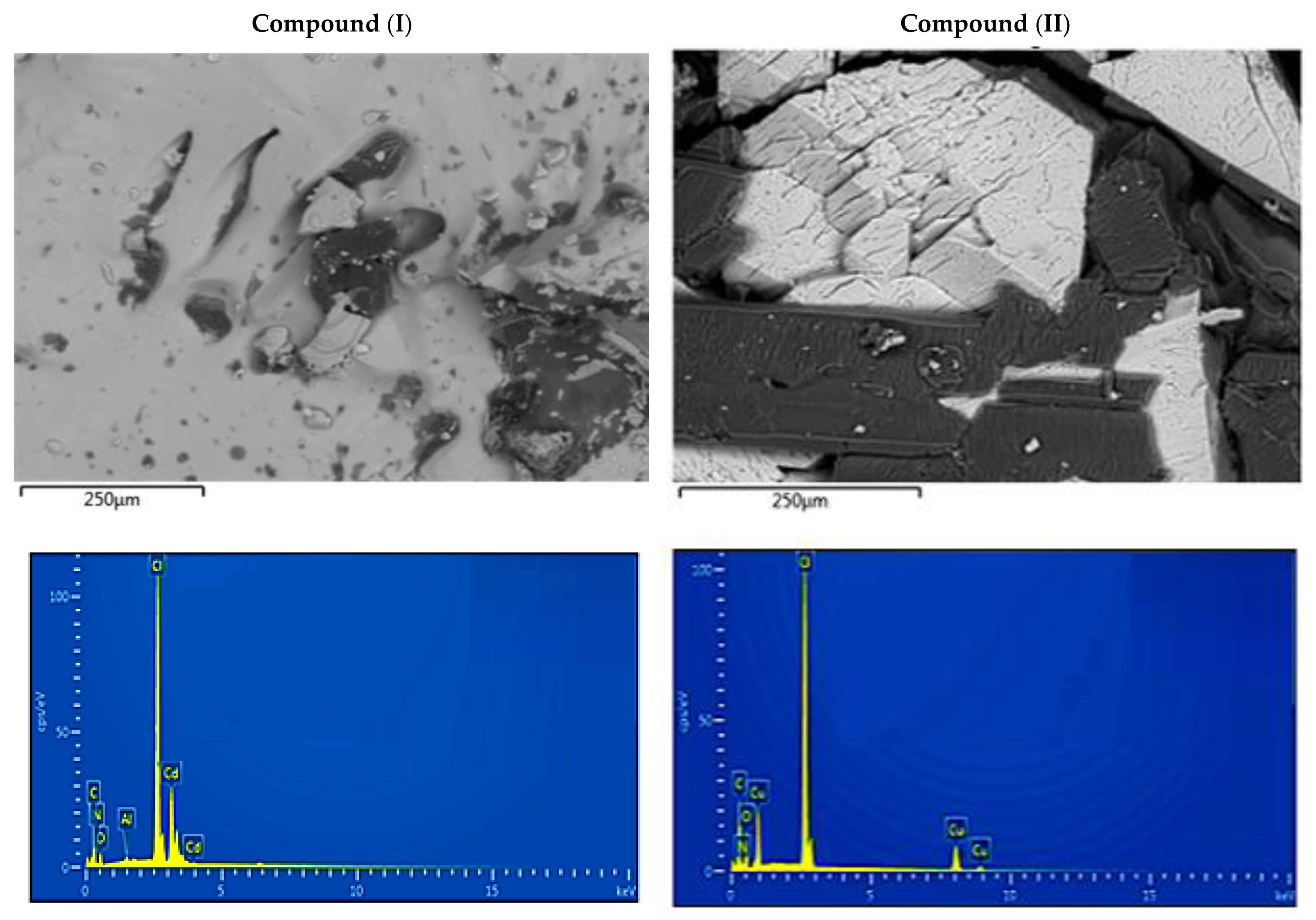
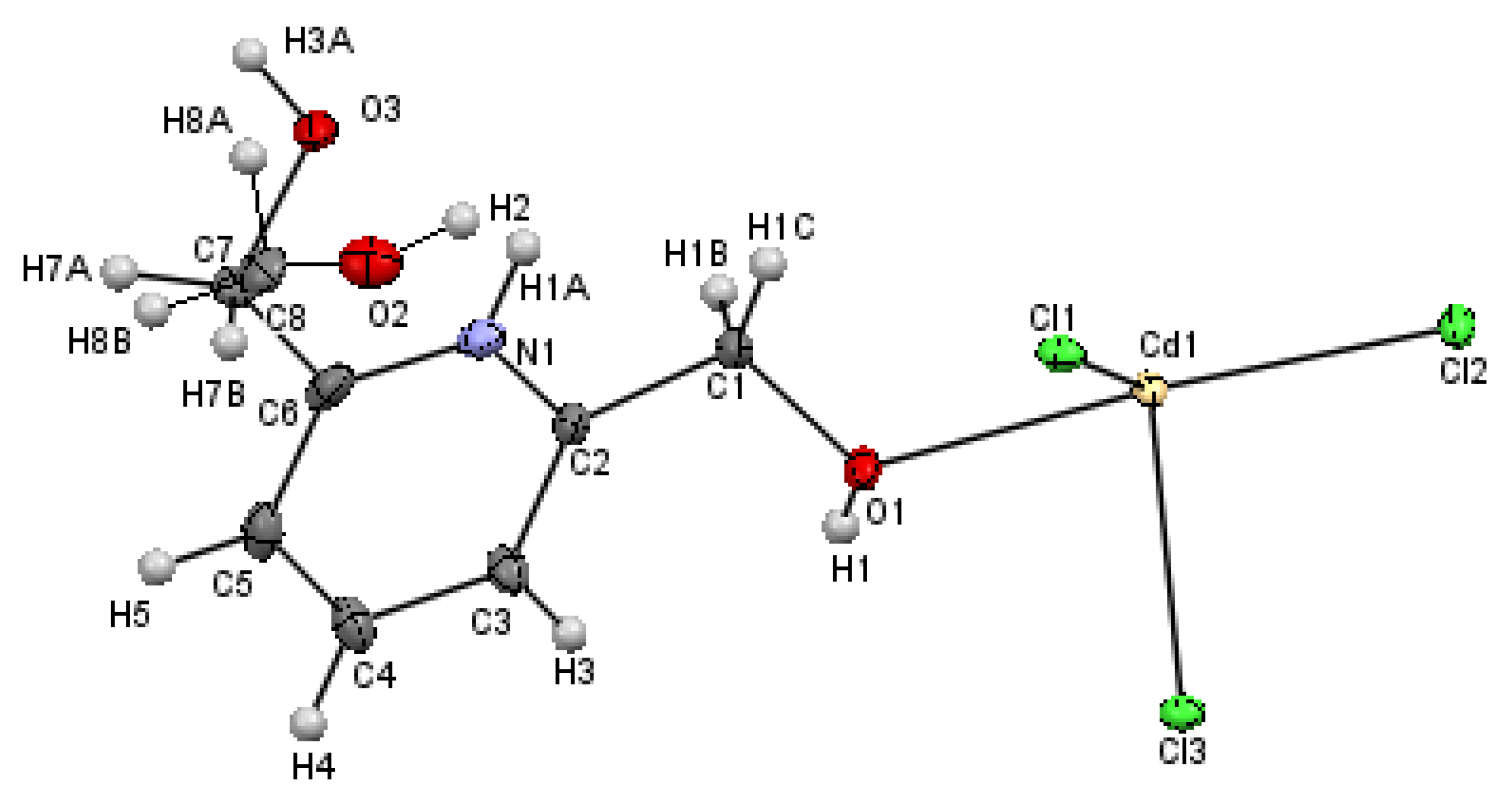

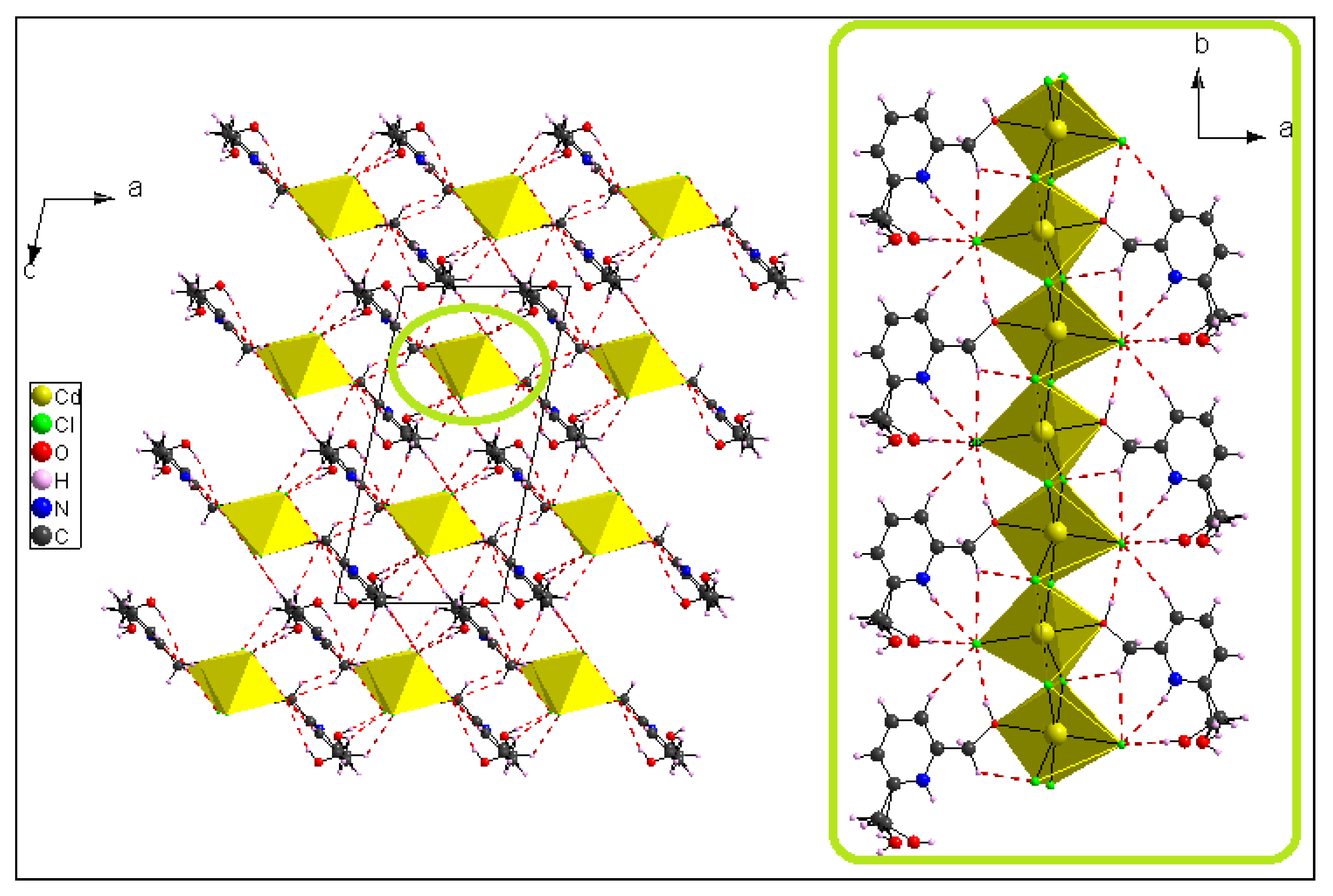
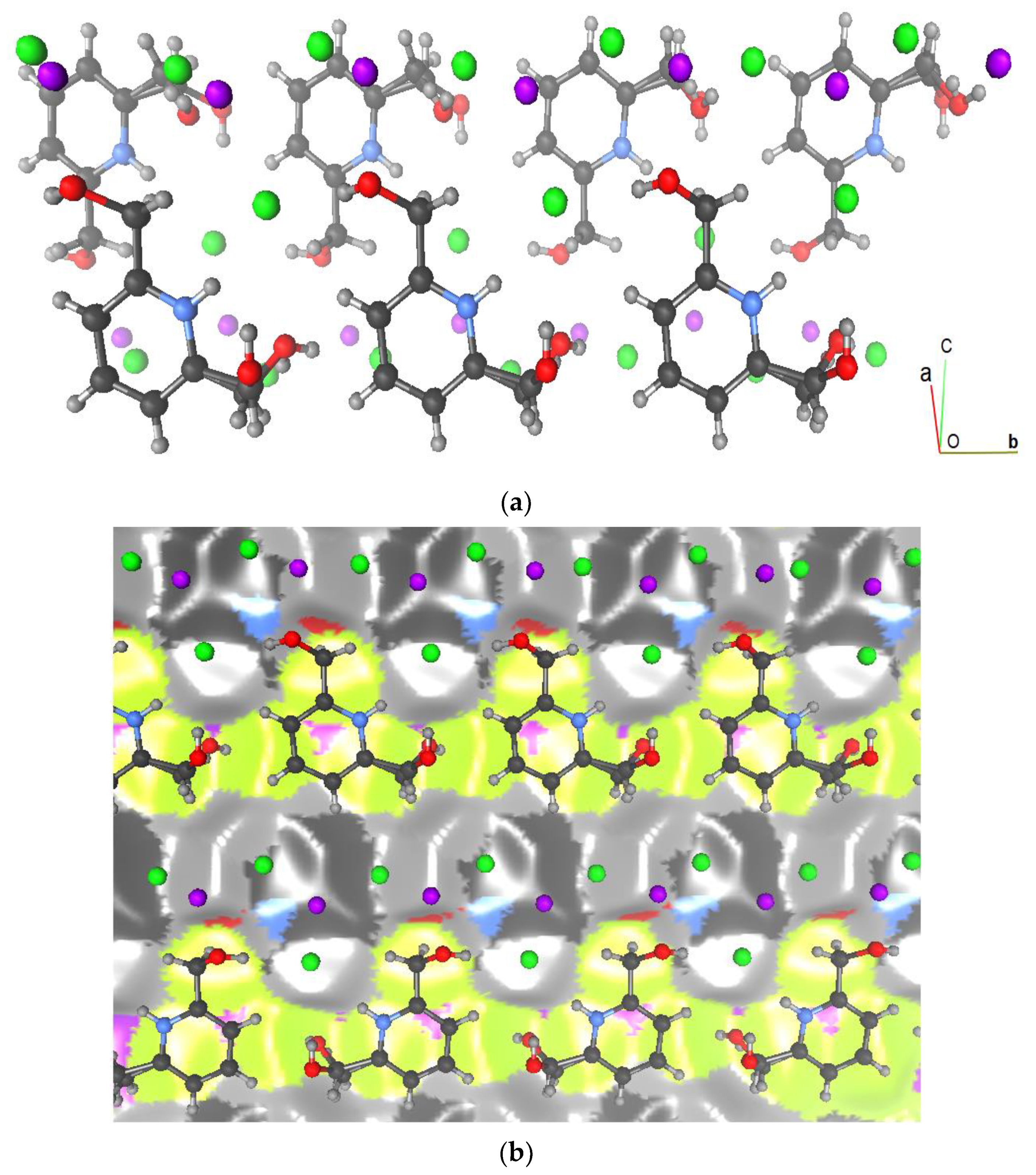

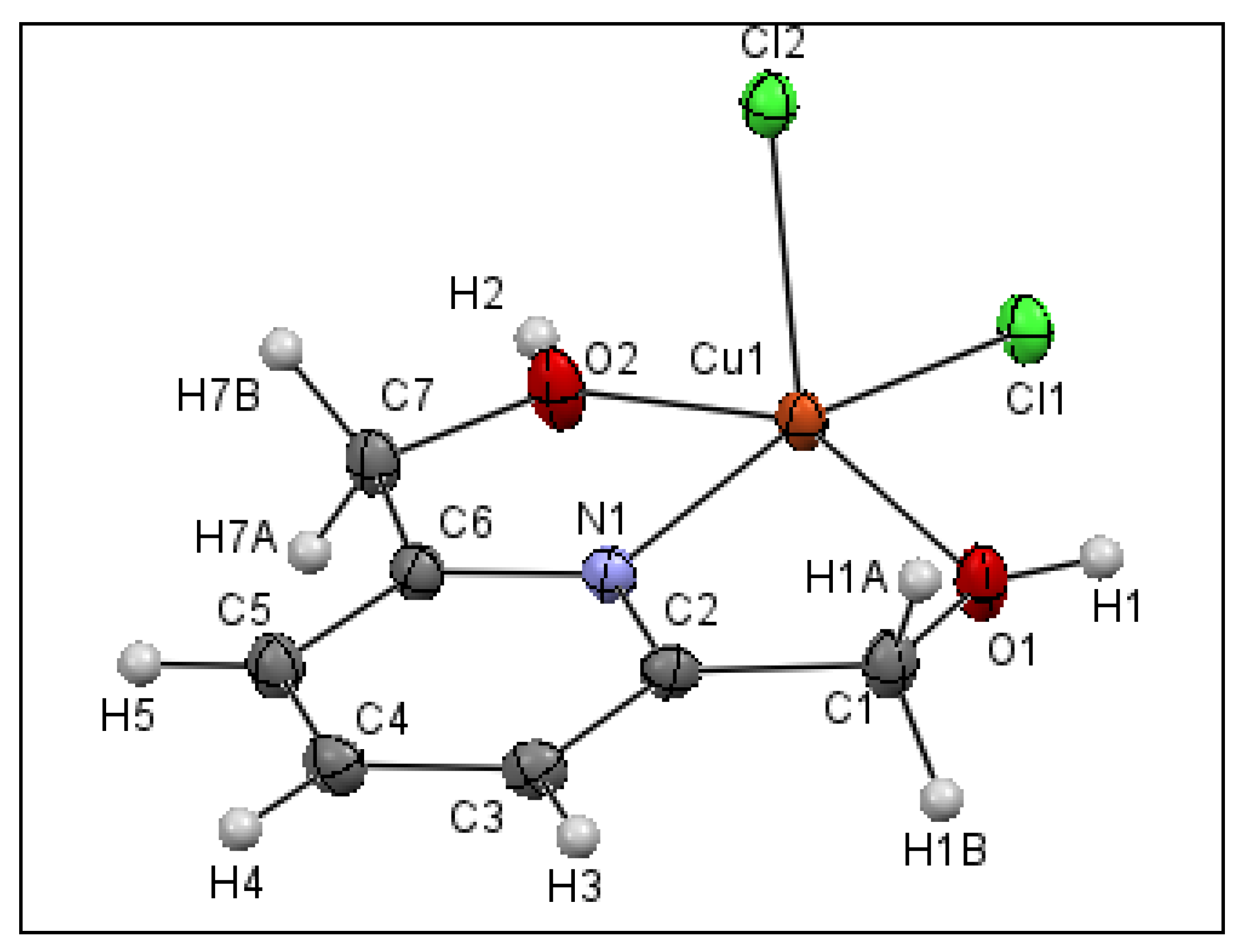
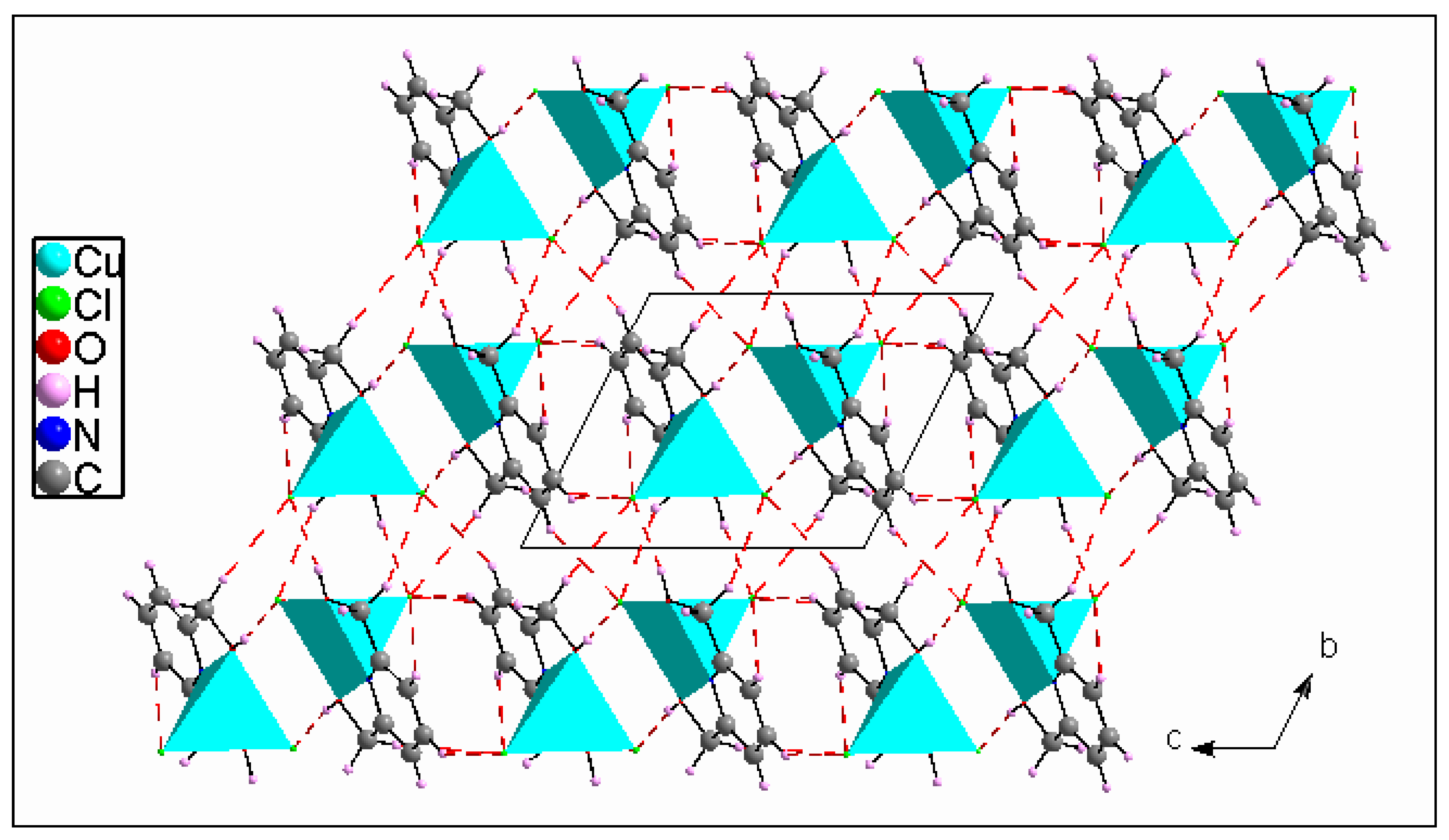
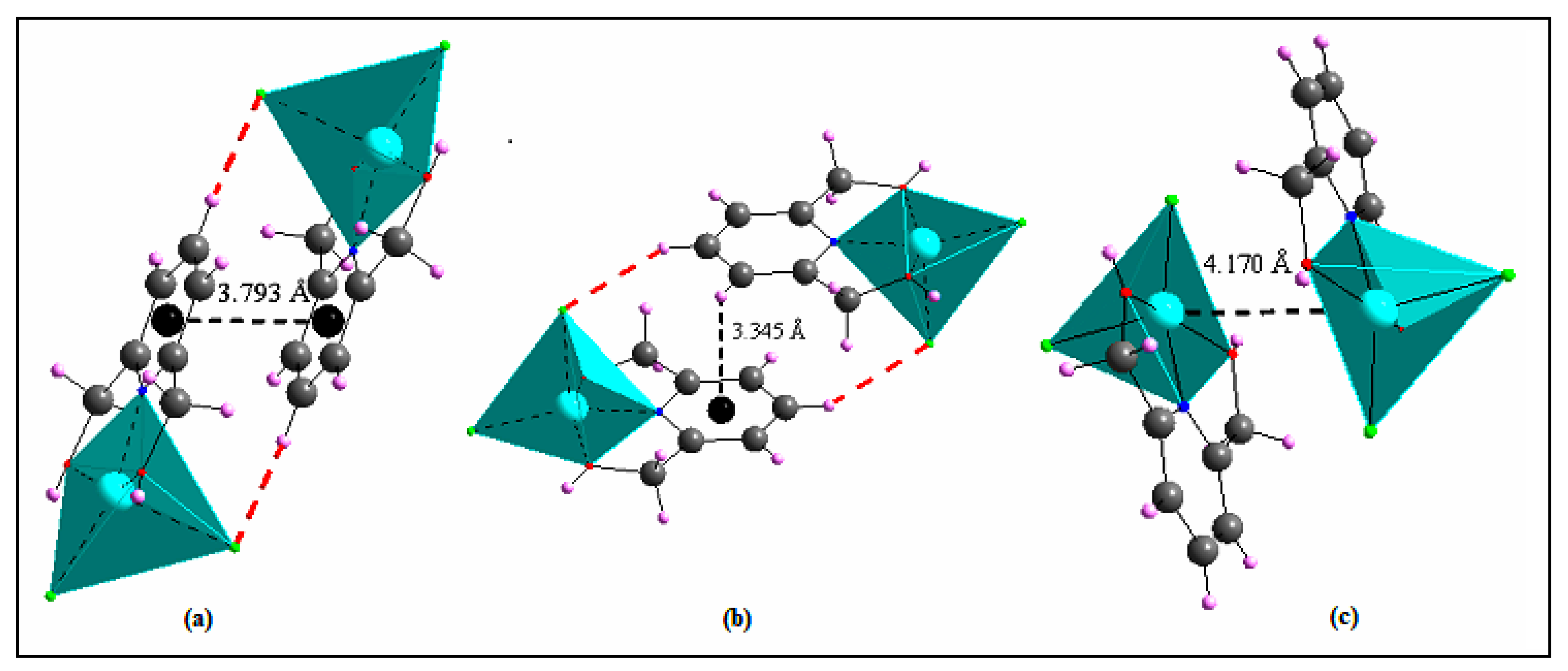

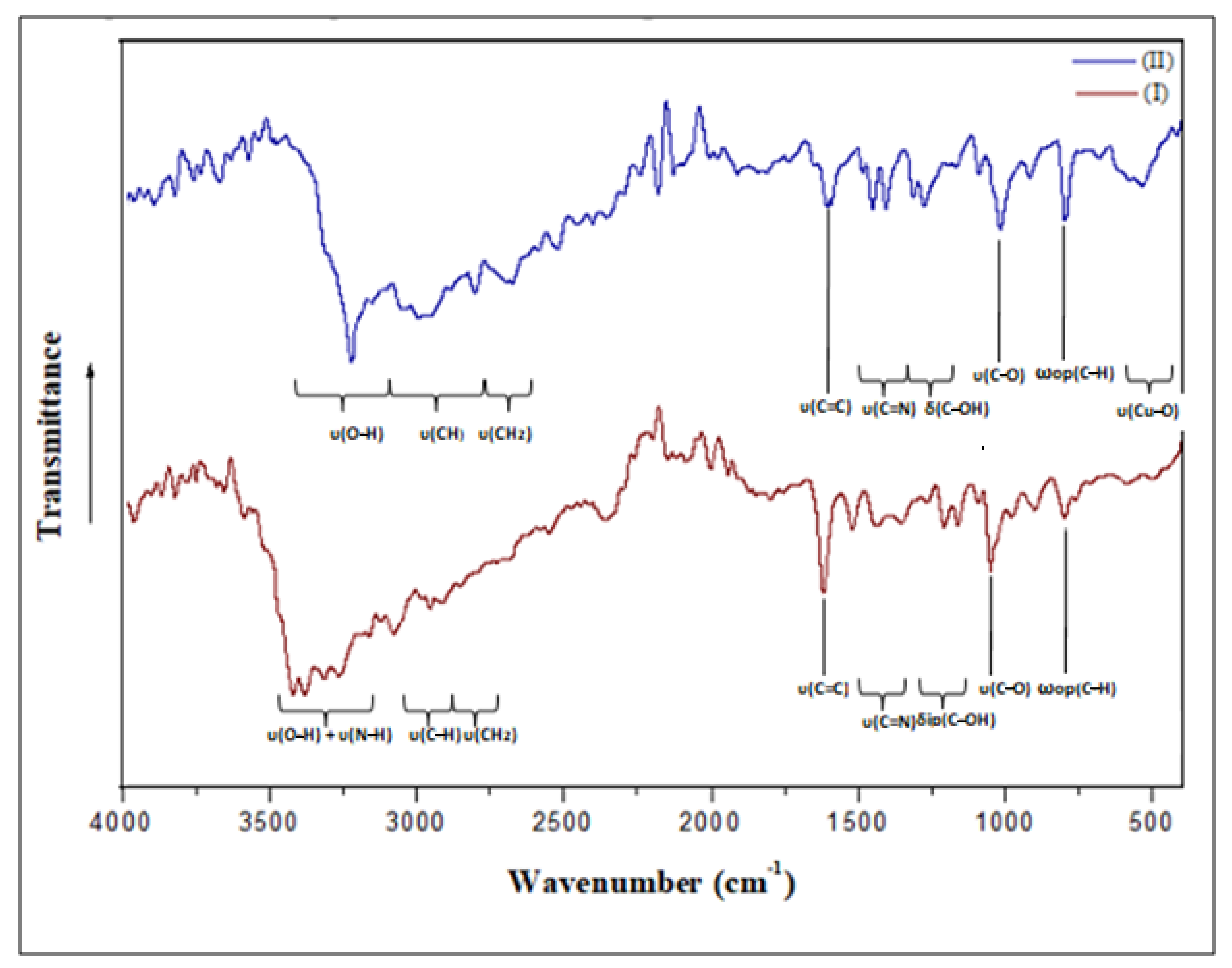
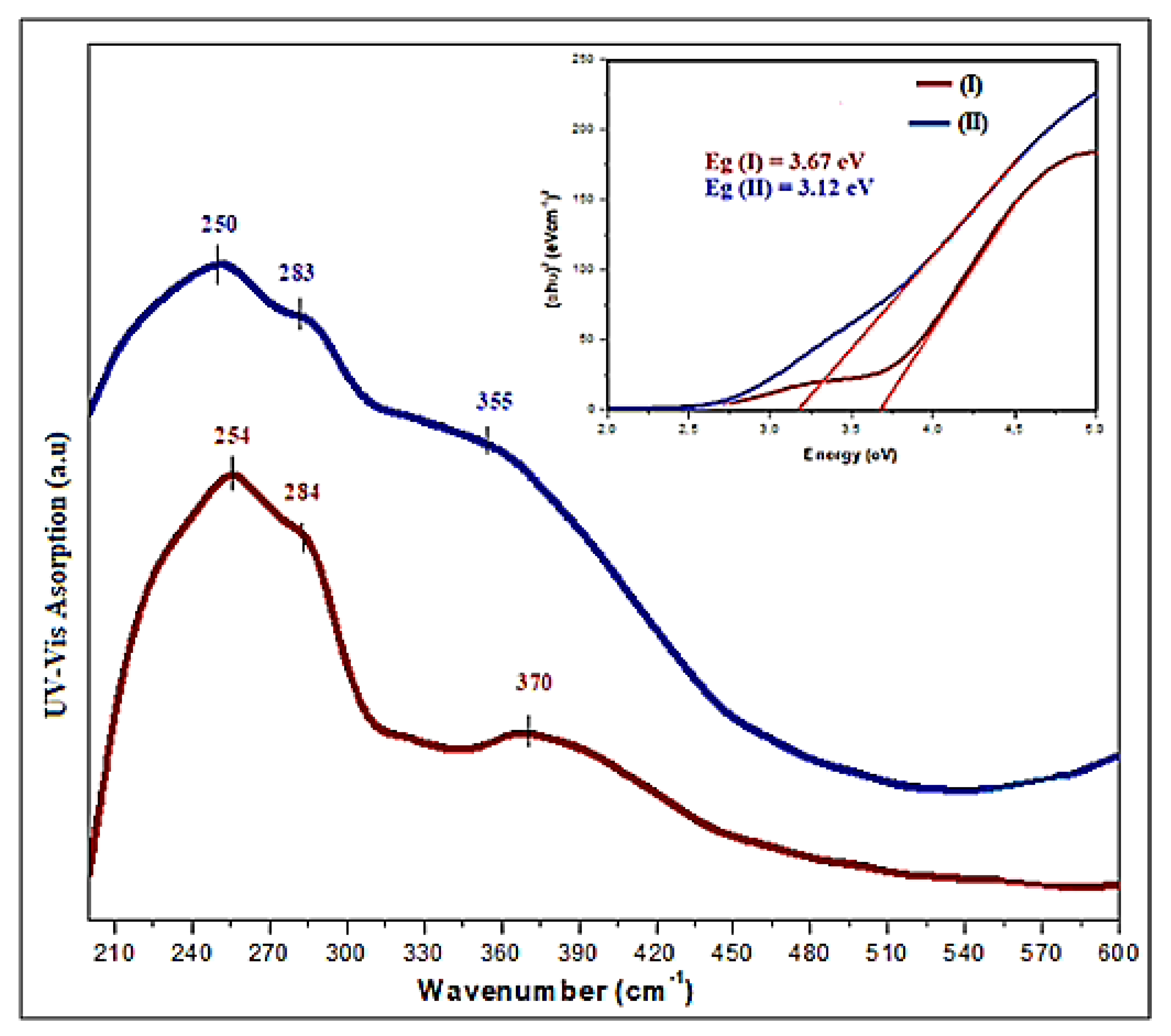
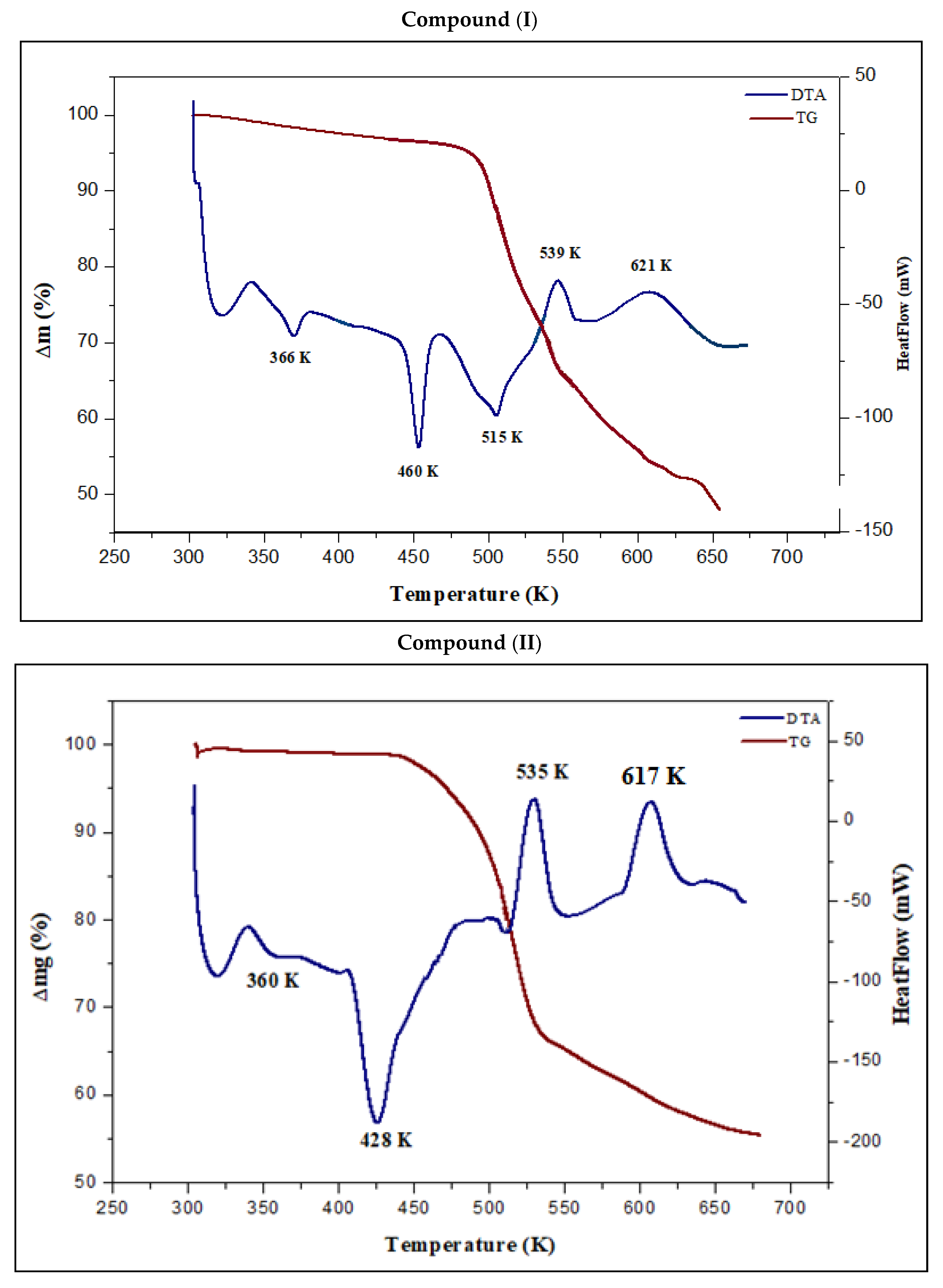
| Compound (I) | Compound (II) | |
|---|---|---|
| Crystal data | ||
| Chemical formula | C7H10CdCl3NO2 | C7H9Cl2CuNO2 |
| Mr(g.mol−1) | 358.91 | 273.59 |
| Crystal system Space group | Monoclinic P21/c | Triclinic P |
| Temperature (K) | 100 | 100 |
| a, b, c (Å) | 8.65880(10), 7.62320(10), 16.8690 (2) | 7.0814(5), 7.9041(6), 9.6875(7) |
| α (°) | 90 | 113.196(2) |
| β (°) | 102.2540(10) | 104.142(2) |
| γ(°) | 90 | 98.578(2) |
| Volume (Å3) | 1088.12 (2) | 464.61 (6) |
| Z | 4 | 2 |
| Radiation type | Mo Kα | Mo Kα |
| Absorption μ (mm−1) | 2.715 | 2.89 |
| Crystal size (mm) | 0.159 × 0.112 × 0.109 | 0.23 × 0.20 × 0.15 |
| Data collection | ||
| Diffractometer | SuperNova, Atlas CCD | D8 Venture, PIII C14 |
| Absorption correction | Multi-scan | Multi-scan |
| Tmin, max | 0.760, 0.950 | 0.595, 0.747 |
| No. of measured, independent and observed (I > 2σ(I)) | 76,249, 8978, 7772 | 21,702, 4496, 3914 |
| Rint | 0.0324 | 0.040 |
| (sin θ/λ)max(Å−1) | 0.997 | 0.834 |
| Refinement | ||
| R[F2 > 2σ(F2)], wR(F2), S | 0.0204, 0.0484, 1.156 | 0.032, 0.08, 1.07 |
| No. of reflections | 8978 | 4496 |
| No. of parameters | 151 | 120 |
| No. of restraints | 8 | 0 |
| Δρmax, Δρmin(eÅ−3) | 1.33, −1.18 | 0.72, −1.25 |
| CCDC No | 2,104,624 | 2,104,625 |
| Compound (I) | |||||||
|---|---|---|---|---|---|---|---|
| Atom | Cd | Cl | O | H-O/H-N | N | H-C | C |
| Surface% | 11.8 | 35.5 | 8.3 | 9.8 | 0.9 | 21.6 | 12.2 |
| Cd | 0.0 | 24.8 | 3.5 | 0.3 | 0.0 | 1.1 | 0.5 |
| Cl | 0.8 | 1.8 | 11.7 | 0.7 | 23.7 | 8.3 | |
| O | 0.3 | 2.5 | 0.3 | 4.3 | 2.0 | ||
| H-O/H-N | Actual | 0.0 | 0.0 | 3.8 | 1.0 | ||
| N | Contacts | (%) | 0.0 | 0.1 | 0.6 | ||
| H-C | 2.1 | 2.1 | |||||
| C | 3.8 | ||||||
| Cd | 0.01 | 2.28 | 1.49 | 0.09 | / | 0.19 | 0.14 |
| Cl | 0.06 | 0.32 | 1.67 | / | 1.66 | 1.04 | |
| O | / | 1.73 | / | 1.46 | 1.21 | ||
| H-O/H-N | / | 1.01 | 0.46 | ||||
| H-C | Enrichment | / | 0.55 | 0.49 | |||
| C | / | 3.16 | |||||
| Compound (II) | |||||||
| Atom | Cu | Cl | O | N | H-O/H-N | Hc | C |
| Surface% | 13.2 | 28.0 | 7.0 | 2.9 | 7.2 | 26.9 | 14.7 |
| Cu | 1.3 | 14.7 | 10.1 | 4.6 | 1.7 | 1.4 | 2.3 |
| Cl | 0.2 | 0.0 | 0.1 | 8.5 | 26.4 | 6.3 | |
| O | 0.2 | 0.0 | 0.0 | 1.0 | 0.5 | ||
| N | Actual | 0.0 | 0.0 | 0.0 | 0.2 | ||
| H-O/H-N | Contacts | % | 0.0 | 1.7 | 1.2 | ||
| H-C | 6.7 | 6.9 | |||||
| C | 4.2 | ||||||
| Cu | 0.40 | 1.40 | 4.30 | 4.78 | 0.69 | 0.15 | 0.45 |
| Cl | 0.02 | 0.00 | 0.07 | 2.31 | 1.85 | 0.87 | |
| O | / | / | / | 0.33 | 0.33 | ||
| N | / | / | 0.00 | / | |||
| H | / | 0.50 | 0.71 | ||||
| H-C | Enrichment | 1.04 | 1.07 | ||||
| C | 2.62 | ||||||
Publisher’s Note: MDPI stays neutral with regard to jurisdictional claims in published maps and institutional affiliations. |
© 2022 by the authors. Licensee MDPI, Basel, Switzerland. This article is an open access article distributed under the terms and conditions of the Creative Commons Attribution (CC BY) license (https://creativecommons.org/licenses/by/4.0/).
Share and Cite
Hermi, S.; Alotaibi, A.A.; Alswieleh, A.M.; Alotaibi, K.M.; Althobaiti, M.G.; Jelsch, C.; Wenger, E.; Nasr, C.B.; Mrad, M.H. The Coordination Behavior of Two New Complexes, [(C7H10NO2)CdCl3]n(I) and [(C7H9NO2)CuCl2] (II), Based on 2,6-Dimethanolpyridine; Elaboration of the Structure and Hirshfeld Surface, Optical, Spectroscopic and Thermal Analysis. Materials 2022, 15, 1624. https://doi.org/10.3390/ma15051624
Hermi S, Alotaibi AA, Alswieleh AM, Alotaibi KM, Althobaiti MG, Jelsch C, Wenger E, Nasr CB, Mrad MH. The Coordination Behavior of Two New Complexes, [(C7H10NO2)CdCl3]n(I) and [(C7H9NO2)CuCl2] (II), Based on 2,6-Dimethanolpyridine; Elaboration of the Structure and Hirshfeld Surface, Optical, Spectroscopic and Thermal Analysis. Materials. 2022; 15(5):1624. https://doi.org/10.3390/ma15051624
Chicago/Turabian StyleHermi, Sabrine, Abdullah A. Alotaibi, Abdullah M. Alswieleh, Khalid M. Alotaibi, M. G. Althobaiti, Christian Jelsch, Emmanuel Wenger, Cherif Ben Nasr, and Mohamed Habib Mrad. 2022. "The Coordination Behavior of Two New Complexes, [(C7H10NO2)CdCl3]n(I) and [(C7H9NO2)CuCl2] (II), Based on 2,6-Dimethanolpyridine; Elaboration of the Structure and Hirshfeld Surface, Optical, Spectroscopic and Thermal Analysis" Materials 15, no. 5: 1624. https://doi.org/10.3390/ma15051624






